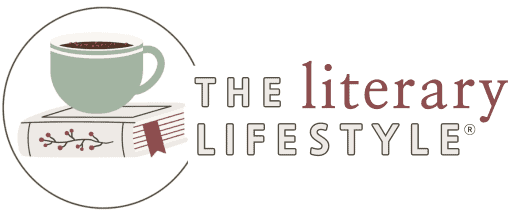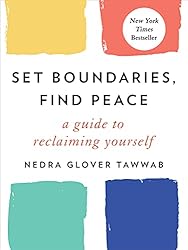If you are struggling with how to set boundaries for yourself, the book discussed below will CHANGE. YOUR. LIFE. I call it the Boundaries Bible!
I made it a goal to set better boundaries, given the growth of my blog (literally thousands of hours and thousands of dollars) while also working a full-time job, achieving my reading goals, and everything else that encompasses being a human.
I used to be paralyzed with guilt and feeling overwhelmed and taken advantage of every time a request came in for me to promote someone’s book or product for free. I was getting at least one request a day, and even saying “yes” to just a handful would lead to another week’s worth of work in my already jam-packed, seven-days-a-week work schedule.
Then, it got to the point where I had no choice BUT to learn how to set boundaries and say “no,” and nothing has ever felt better.
How to Say No Without Hurting Someone’s Feelings
The seven examples below will help you to say “no” without hurting someone’s feelings. Although “no” is a complete sentence, it can feel awkward in practice to just say “no” and nothing else.
It feels better to be extra polite, but at the same time, you also may not want to get yourself into a never-ending cycle of making excuses and defending your choices.
What’s great about the self-care ideas below is that you can also mix and match them to create a unique definitive statement that works best for you and/or a given circumstance.
- “No, thank you.”
- “I’m going to pass.”
- “Not right now, but thank you for thinking of me.”
- “I wish I could, but I’m not available.”
- “I would love to, but now is not a good time.”
- “Maybe another time.”
- “For a variety of reasons, I have to pass at this time.”
And if you REALLY need to reiterate NO to a persistent person, you can get more assertive with the following statements:
- “No. Please stop asking me that question.”
- “I’ve already said no. I don’t want to continue to repeat myself.”
- “If I change my mind, I will let you know.”
- “No. Please respect my answer.”
- “My answer is still no.”
In the context of work, I have also implemented the following more subtle ways to say “no” and/or prevent requests that overstep my boundaries in the first place:
- Reiterating some of my boundaries on my Contact page so people can see them before making requests;
- Negotiating for payment for my work to turn a yucky feeling “no” into a more collaborative “yes;”
- Limiting my time on social media, including by turning off notifications and placing my phone out of reach; and
- Developing strategies that are mutually beneficial to me AND those making requests WITHOUT taking up too much of my time, so I can point people to options that do work instead of just saying “no” (like pointing people to relevant blog posts).
Now onto the book that helps…
As I was implementing these strategies, I heard of the top self-help book Set Boundaries, Find Peace: A Guide to Reclaiming Yourself by Nedra Glover Tawwab, and I knew I had to read it. I started the audiobook and, within ten minutes, I purchased a hard copy because it was already so jam-packed with information, I wanted to highlight it and refer back to it over time. That’s ALWAYS the mark of an excellent book for me.
This book will help you learn invaluable information about how to set boundaries for yourself.
How to Set Boundaries for Yourself
To give you a head start on how to set boundaries for yourself, below I review Set Boundaries, Find Peace: A Guide to Reclaiming Yourself by Nedra Glover Tawwab with some highlights and my personal thoughts on them. But really, you need to READ the whole book yourself AND highlight it AND take your own notes too. It’s THAT good and it is THE book I recommend for a New Year’s resolution (or just a general goal!) to set boundaries.
Book Review: Set Boundaries, Find Peace: A Guide to Reclaiming Yourself by Nedra Glover Tawwab
Instant New York Times bestseller
(Nedra Glover Tawwab is a licensed counselor, sought-after relationship expert, and one of the most influential therapists on Instagram.)
Boundaries will set you free.
– Nedra Glover Tawwab
As I mentioned earlier, Set Boundaries, Find Peace: A Guide to Reclaiming Yourself is “the Boundaries Bible.” It discusses:
- what boundaries are;
- the cost of not having healthy boundaries;
- why we don’t have healthy boundaries;
- six types of boundaries;
- boundary violations;
- how to identify and communicate your boundaries;
- clarifying your boundaries;
- trauma and boundaries;
- honoring your boundaries;
- setting boundaries with family;
- setting boundaries in romantic relationships;
- setting boundaries at work; and
- setting social media boundaries.
It’s a comprehensive guide to how to set boundaries for yourself and respect others’ boundaries.
Some things I learned that really stood out to me:
Setting boundaries will ALWAYS make you feel guilty.
It’s part of the process and, if you don’t set boundaries, you just victimize yourself further. This is such a game-changer! I know I have personally failed to set boundaries because I didn’t know how to set them without guilt. Now I know that’s not possible.
You need to clearly verbalize your boundaries, repeatedly and in uncertain terms.
It’s just not reasonable to think we can “set it and forget it” when we engage with a variety of people on a daily basis.
When we feel resentment, we act out of obligation, and not joy.
Setting a boundary is about choosing discomfort over resentment. This statement helped me realize that begrudgingly saying yes to someone may actually be worse for them. I know I wouldn’t want someone to do something for me solely out of resentment and obligation.
Use statements that begin: “I feel…”, “I need…” and “I expect…”
This is both clear and non-confrontational.
Most people apologize or explain their boundaries. You do NOT have to do so.
In my experience, explanations can also lead to bargaining-type arguments in which you are then required to either continue to defend your decision or give in.
Having healthy boundaries also means hearing “no” and not taking it personally.
I actually love it when someone clearly states “no” to me. It makes me feel like they can be comfortable being honest with me.
When someone tests your boundaries, tell them how it makes you feel.
Remember to focus on your feelings, not their actions.
Anxiety can be triggered by the inability to say no.
This was such a huge a-ha moment for me. I realized how often requests for my time were putting me into an actual anxiety attack before I set my boundaries. I have now been able to re-frame these circumstances as opportunities to set boundaries now, and that feels infinitely better than struggling to say no.
People struggle the most with time boundaries.
This has definitely been my biggest boundary struggle, and I think it springs from our general culture of showing that we can balance it all and feeling like we “must” do things. Even children’s time is burdened by getting good grades at school, excelling at extracurricular activities, volunteering, and working via chores or a part-time job.
Passive aggressiveness is the top way we communicate our feelings.
I’m not really surprised by this. The older I get and the more I read, the more I realize how truly terrible humans generally are at clear communication. I’m making it an intention for myself to be mindful when I’m tempted to communicate this way.
If someone is taking advantage of you, think about how you have allowed them to do so.
This is true. At the end of the day, we can only control our own reactions, and we need to remember that pleasing someone else can further victimize us personally.
When someone asks you a question that violates your boundaries, ask them why they asked you and/or tell them you don’t feel comfortable with that question.
I really appreciated these tips. So often, many of us can freeze when asked a personal question or feel compelled to answer. Why? For years, I have told myself that, if someone is bold enough to ask, I need to be bold enough to shut down the question.
The more you set boundaries, the easier they become.
I definitely agree with this. Having started implementing boundaries, I feel so positive and free in doing so. I now look at it as just conveying my rules, not an insurmountable task. For example, it’s like working at a store and reiterating a 30-day return policy to a customer. It’s just the way it works around here!
Listening without offering advice is loving.
It is empowering to let someone work through his or her own problem. I loved this advice to respect other people’s boundaries, and I am actively trying to work on this. It’s a natural instinct to want to help, but oftentimes, we just can’t, or we may say something worse or unhelpful. Sometimes, we all just need to hear, “I’m sorry, and I am here to go through this by your side.”
To respect someone else’s boundary, tell them you understand, and repeat the boundary back to them.
I found this to be helpful as well, and it has helped me in communicating with my husband so he feels seen and heard. When we hear something parroted back to us, we know the other person “gets it.”
Remember that setting boundaries is not “mean” — it’s a necessary part of healthy living.
This has been my biggest lesson of all! And honestly, when you set boundaries, people generally go on living just the same as if you hadn’t set them. The real difference is how YOU feel.
Buy Set Boundaries, Find Peace:


